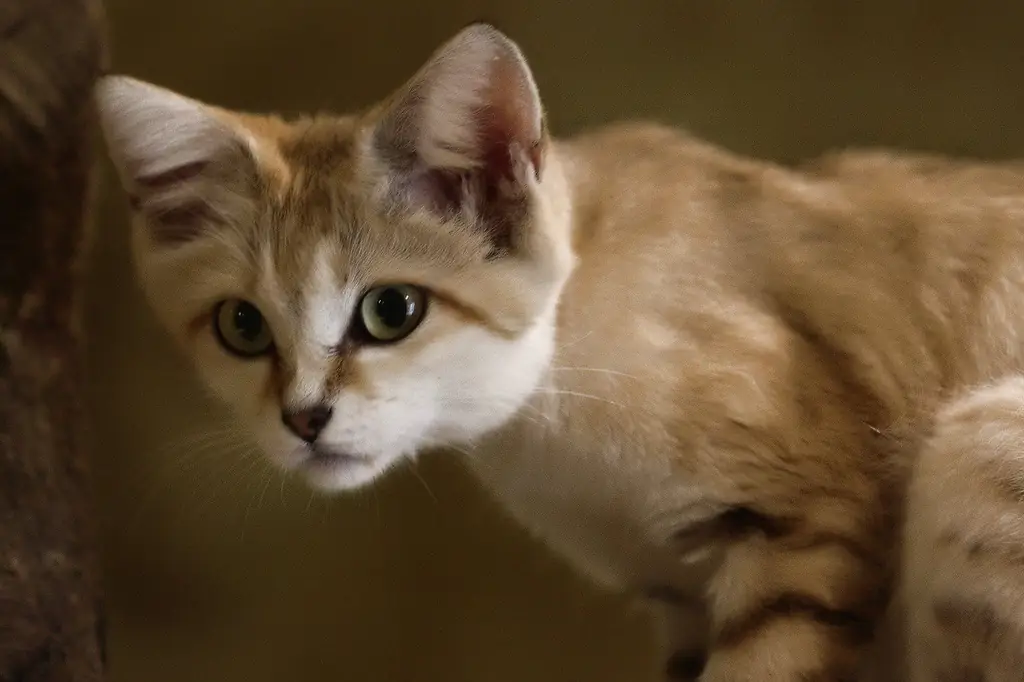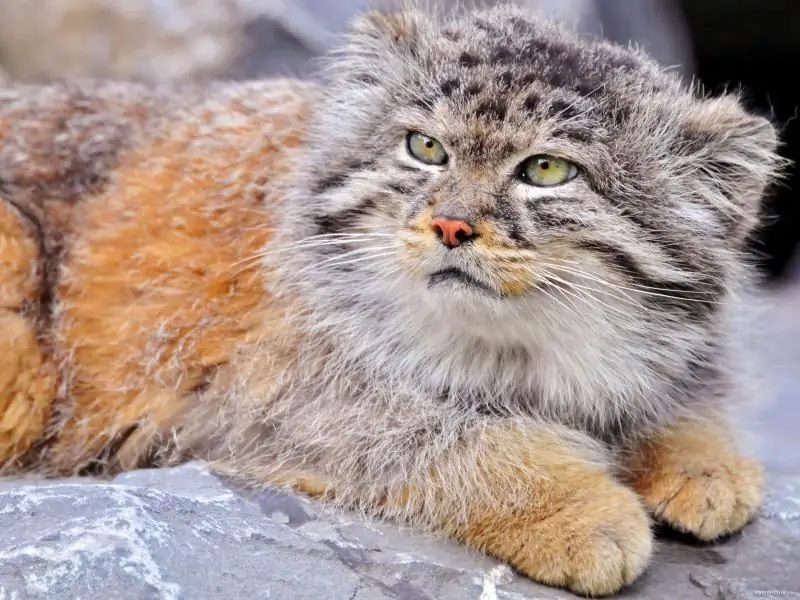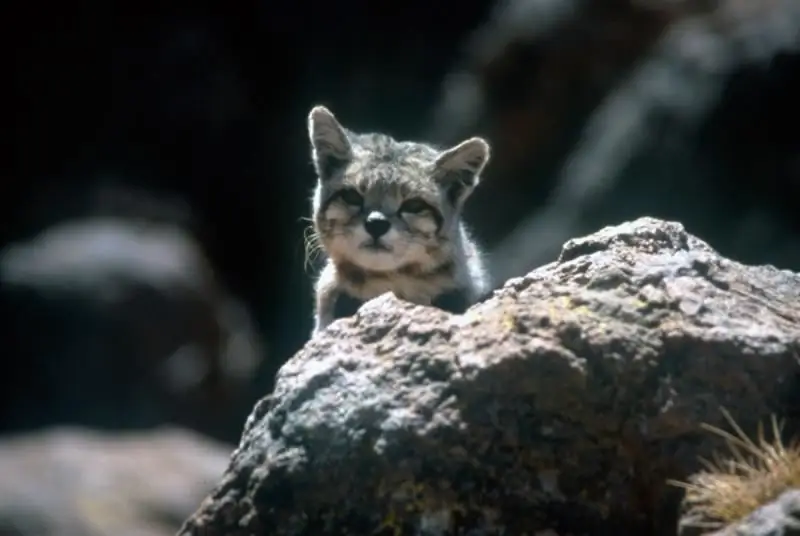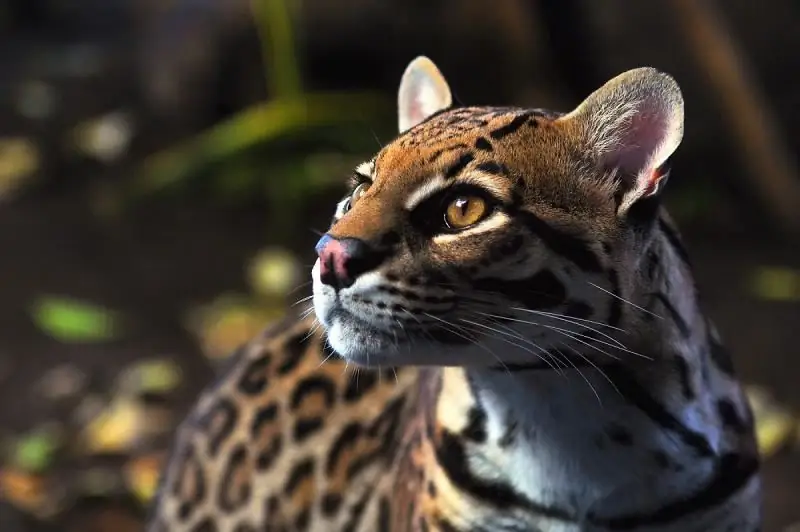
Table of contents:
- Author Bailey Albertson [email protected].
- Public 2024-01-17 22:26.
- Last modified 2025-06-01 07:32.
The sand cat is the smallest among wild cats

The sand cat (Felis margarita) was first discovered in 1858 in North Africa. Later, in the middle of the 19th century, during the Algerian expedition led by the French general Jean Auguste Margueritte, it got its official name. It was in honor of the general that this wild cat began to be called Felis margarita.
Content
-
1 Appearance
1.1 Photo gallery: appearance of a sand cat
-
2 Habitat and lifestyle
2.1 Video: sand cat kittens
- 3 Sandy cat at home
Appearance
The sand cat is the smallest representative of wild cats. Its body grows in length only up to 65-90 cm (of which 40% is the tail). At the withers, it reaches a size only up to 24-30 cm. Males weigh from 2 to 3.5 kg, females differ in males in smaller sizes.
The head of this type of cat is large and wide, slightly flattened. There are sideburns on the cheeks. The ears are large and wide. The eyes are yellow. Legs are short and strong. Since in its natural environment the dune cat lives in places with hot sand from the sun, nature has taken care of protecting its paws. On the feet of this cat there is a hard hair that protects from burns.
The coat of sand cats is short, but thick, protecting from temperature extremes during the day and night. The color is from sandy to light gray, which allows the dune cat to successfully camouflage. The back and tail are covered with darker stripes that can merge with the general color. On the head and legs, these stripes are brighter. The tail is black at the end. The ribcage and bottom of the muzzle are lighter than the general tone. Dune cats that live in Central Asia change their fur to a thicker, pale sandy color with a grayish tint in winter.
The color of the cat also differs from its subspecies:
- Fm margarita can be found in the Sahara. This species is the smallest of the dune cats. It has the brightest color, and on its tail you can count from 2 to 6 dark stripes.
- Fm thinobia, or Transcaspian sand cat. The largest among other species. But its color is dull, the pattern is barely noticeable. The tail has up to 3 rings.
- Fm scheffeli from Pakistan in color is similar to the Transcaspian sand cat, but differs from it in a brighter pattern and more stripes on the tail.
- Fm harrisoni, found in the Arabian Peninsula, is distinguished from others by a dark spot on the back of the ear. Also, adult cats have 5 to 7 rings on their tail.
Photo gallery: the appearance of a sand cat
-

Sand cat on a stone -
Most often in nature there is a sandy dune cat, but you can also see gray individuals
-

Sand cat and his 2 kittens - The sand cat is the smallest representative of wild cats.
-

Sandy cat on the background of a sandy landscape - The color of the sand cat is ideal for camouflage in natural conditions
Habitat and lifestyle
Sand cats live in harsh natural conditions, in which not everyone can survive. These wild felines are found in the Sahara Desert, the Arabian Peninsula, Central Asia (Turkmenistan, Uzbekistan and Kazakhstan) and Pakistan.

The subtropical, tropical and dry continental climate in the habitat of the sand cat has left its mark on its appearance and habits.
The existence of the sand cat is further complicated by the lack of a water source. Such conditions could not but affect the way of life of these animals. They are active only after sunset, when the heat of the day subsides. Until that time, cats sleep in holes dug by their own, perfectly adapted for this, or in shelters abandoned by their previous owners. Minks are perfect for them after foxes, porcupines, corsacs. Only at nightfall do dune cats leave their home to hunt.
As a predator, the sand cat eats almost all the game that it encounters on the hunt. His diet includes small rodents, lizards, insects, tolai hares, birds. He can also hunt poisonous snakes. The area on which this animal hunts may be more than 15 km 2.
Since there is a problem with water in the habitats of the sand cat, this animal has adapted to receive the necessary moisture from food for many centuries of its existence
These tiny predators also have enemies. Large snakes, monitor lizards, large birds of prey, jackals are ready to feast on this small animal.
Reproduction in vivo depends on the habitat of the animal. For example, in the Sahara these wild cats are ready to reproduce from January to April, and in Pakistan from September to October. A sandy cat's pregnancy lasts about 2 months (59-63 days). In one litter, the female brings from 2 to 5 babies. Sometimes their number is even more. Up to 8 kittens. The weight of the crumbs is usually up to 30 g. The eyes of babies open 2 weeks after giving birth, and after 5 weeks the kittens are ready to leave their den for hunting. At about six months of age, kittens become completely independent in order to live independently of their mother. But they reach maturity closer to 1 year (9-14 months).
Video: sand cat kittens
Sand cat at home
A person's love for everything unusual often leads to the purchase of an exotic animal. The dune cat was no exception, and currently it can be purchased for a rather large amount of 6 thousand dollars. But officially, this animal is not for sale, so you can only buy it underground.
At home, with good care, sand cats live an average of 13 years. Even acquired very little, the dune cat is highly susceptible to its instincts. One need not be surprised if some of his morning food is found under his pillow one day.
This wild animal can be tamed only if the pet is brought into the house as a kitten. To do this, you should adhere to the following rules:
- Hand-feed more often.
- Do not play with the kitten with your own hands. This can lead to their injury, as the claws and teeth of an adult pet are very sharp and strong.
- Do not physically punish the animal or raise your voice at it.
- To accustom to the command "no".
- All household members should show attention to the animal so that it equally well perceives all the inhabitants of the house.
Despite the fact that attempts to domesticate the dune cat were successful, it is unlikely that it will be possible to completely tame it. There were cases when a pet acquired as a kitten, having matured, began to behave aggressively towards others.
Like any other wild animal, the dune cat must be allowed freedom of movement. In a cramped city apartment, he will be exposed to stress, which often leads to a severe deterioration in the animal's health. Therefore, a private house is the best place to live for a sand cat. It is also very important to create an optimal indoor climate in which the dune cat will live. High humidity can be detrimental to your pet, so it must be kept low.
A domesticated sand cat should be vaccinated and included in its diet several types of meat, preferably beef and poultry. The cat eats up to 600 g of meat per day. It is important to know that you cannot feed this animal with industrial feed. Also, do not add fiber and grains to food, since the gastrointestinal tract of this cat does not digest them.
Sand cats get used to the litter box pretty quickly. They can even be taught some commands.

When keeping a dune cat in captivity, you need to take care of sufficient space for its free movement
If you want to have some exotic animal at home, do not forget that it will still partially remain wild. The sand cat is no exception. Although he looks like a domestic cat, he will periodically show his character. Being in unnatural conditions for an animal leads to illness and stress. Therefore, it is better for wild animals to live in natural conditions, far from humans.
Recommended:
Pallas' Cat: Lifestyle Of A Cat, Habitat, Keeping In Captivity, Photo, Is It Possible To Tame A Wild Kitten

Wild cat manul: a description of the appearance of the animal, its life, character and behavior of the manul in the wild and when kept in captivity. Power features
Andean Cat: Description Of The Breed, Nature And Habits, Habitat, Keeping In Captivity, Photo

How this rare cat was discovered. What does an Andean cat look like, where it lives in nature, what kind of life it leads, can it be kept in captivity
Ocelot: Appearance, Description Of The Cat, Features Of Keeping At Home, Owner Reviews

The history of the origin of the species. External characteristics. Ocelot life in the wild. Nutrition and behavior. Reproduction of ocelots in the wild. Ocelot at home
York Chocolate Cat: Description Of Appearance, Character And Behavior, Care And Feeding, Breed Photos, Owner Reviews

Where is the breed bred, what are the main external differences, what character does the York chocolate cat have, how to properly care for and feed it
Chinese Cat: Breed Standards, Character And Habits, Health And Nutrition, Photos, Habitats, Keeping In Captivity

History of the Chinese (mountain) cat. What a gobi cat looks like. Where does the Chinese cat live and what it eats. Reproduction issues. Maintenance and care in captivity
